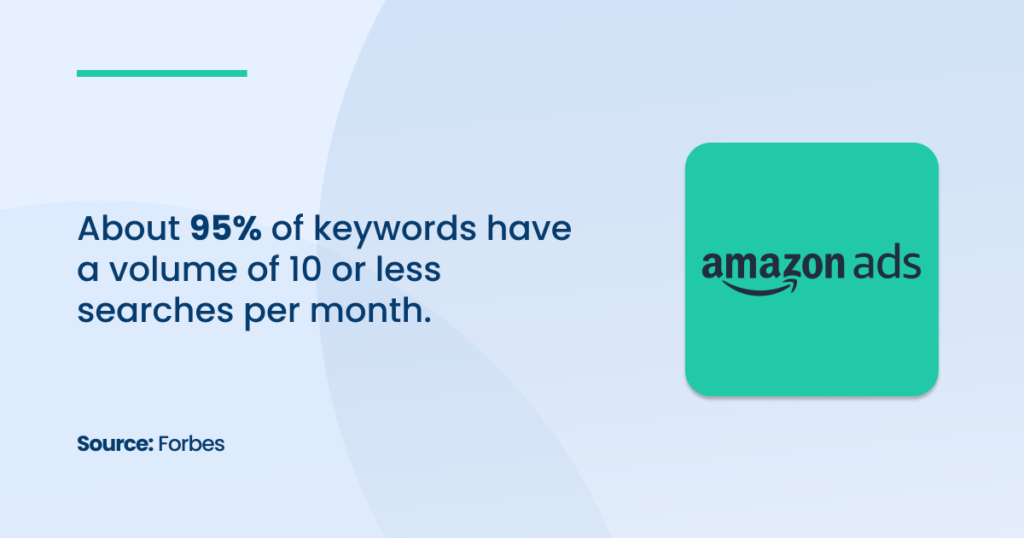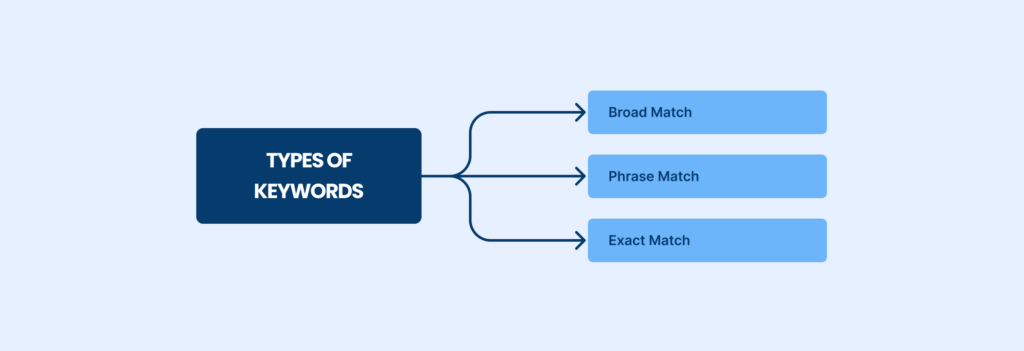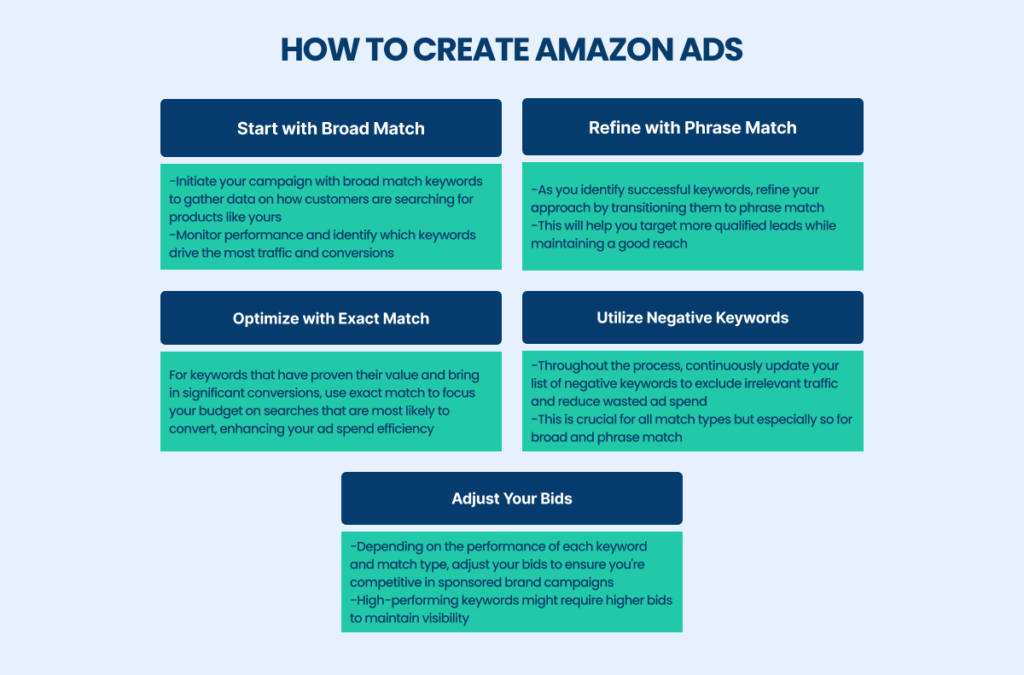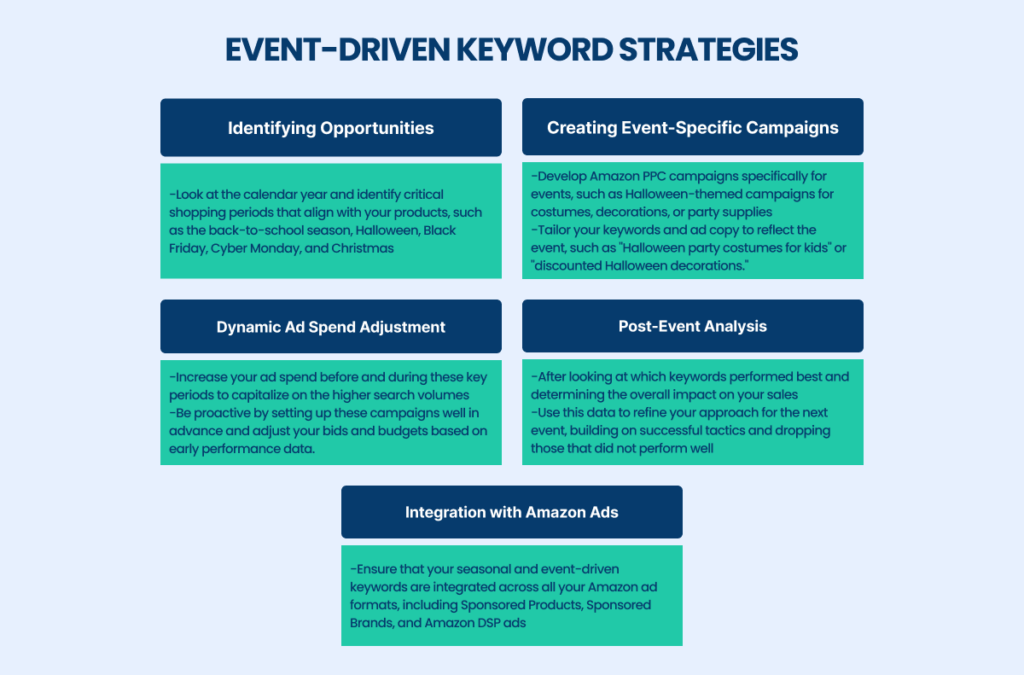Effective keyword optimization is crucial for driving organic and sponsored traffic to your products in Amazon’s competitive landscape.
Understanding and implementing strategic keyword strategies can significantly enhance your product visibility, increase sales, and boost your overall Amazon business.
Google’s search algorithm uses over 200 ranking factors. Keyword Optimization is one of the keys.

As one of the largest online marketplaces, Amazon offers a vast audience and immense potential for sellers to increase visibility and sales through effective advertising.
Accordingly, strategic keyword use should be performed accurately. Amazon Ads Agency will assist in connecting your products to the right customers.
In this guide, we will explore the intricacies of Amazon Ads, focusing mainly on selecting, optimizing, and managing keywords for maximum impact.
Understanding Amazon Advertising Keywords
Amazon Advertising offers a powerful way to connect with potential customers. It leverages the marketplace’s vast search traffic to help sellers and brands gain visibility and sales.
To leverage this potential effectively, it’s vital to grasp the nuances of keyword dynamics within Amazon’s ecosystem. Forbes notes that 14.1% of all keywords are formulated as questions.
Such understanding is essential, as keywords are the cornerstone of successful Amazon ad campaigns, influencing factors ranging from visibility to conversion rates.
Types of Keywords

Broad Match
Broad match keywords allow your ads to show when someone searches for your keyword in any order, including variations of your keyword. This type of match offers the widest traffic exposure.
For instance, if your broad match keyword is “water bottle,” your ad might show for searches like “large water bottle,” “water bottle for hiking,” or “blue water bottle.” This can be particularly useful in capturing a broad audience and help you identify which keywords are most effective through Amazon ads management tools.
When using broad match keywords, it is essential to monitor the Amazon ads’ cost closely, as the extensive reach can lead to higher spending.
Phrase Match
Phrase match offers a balance between reach and relevance. With phrase match, your ads appear for searches that include the exact phrase or close variations of the phrase in the order you specify.
For example, if your keyword is “organic coffee,” your ad could show “buy organic coffee” or “organic coffee beans” but not “coffee organic.“
This match type is precious when your Amazon marketing strategy targets specific queries that relate closely to your product.
Exact Match
Exact match is the most specific and restrictive keyword match type. When you use exact match, your ads only show when someone searches for the keyword you specify or close variations with the same meaning.
Using an exact match for keywords like “women’s running shoes size 8” means your ad will only appear when this precise phrase is searched.
This match type is crucial for optimizing your Amazon ads management, as it allows you to target highly relevant keywords and directly match a user’s search intent.
How to Create Amazon Ads with Effective Keyword Match Types
Creating effective Amazon ads, particularly understanding how to create Amazon ads, involves more than selecting suitable keyword match types. It’s about strategically combining them to optimize both reach and relevance.

Leveraging Sponsored Brands and Campaigns
Sponsored Brand campaigns are an excellent way to use these keyword strategies effectively.
By creating ads featuring your brand logo, a custom headline, and multiple products, you can utilize the researched keywords to target searches most likely to lead to higher engagement and sales. This not only boosts visibility but also enhances brand recognition among Amazon shoppers.
Advertisers can significantly enhance their visibility and effectiveness on Amazon by selecting and managing keywords across broad phrases and exact matches.
Each match type serves a specific purpose in Amazon marketing‘s wider strategy, helping brands reach their desired audience efficiently and effectively.
Developing a Keyword Strategy
Developing a robust strategy is essential for the success of your Amazon ads keywords. The right keywords can increase the visibility of your Amazon Sponsored Ads, Display Ads, and Video Ads, leading directly to increased sales and improved ROI.
This strategy involves finding keywords and identifying the most effective way to reach your target audience and stand out among competitors.
Researching Effective Keywords
Keyword research is Amazon PPC campaigns’ first and perhaps most critical step. Utilizing keyword research tools is indispensable in this process.
Tools like Google Keyword Planner, Ahrefs, SEMrush, and Amazon’s Brand Analytics provide extensive keyword volume, competition, and relevance data. These tools offer insights into which keywords for Amazon ads are most effective for your product category and target market.
Source: Ahrefs Keyword Planner
Another effective technique is to use Amazon’s autocomplete feature to find popular search terms.
Start typing a product-related query into the Amazon search bar and note the autocomplete suggestions that appear. These suggestions are based on actual searches by Amazon customers, providing direct insight into the market’s search habits.
Analyzing Competitor Keywords
Understanding what keywords your competitors target can provide a strategic advantage in your Amazon advertising efforts. Analyzing competitor keywords allows you to adjust your strategy to compete directly with similar keywords or identify gaps in their strategies where you can differentiate yourself.
To analyze competitor keywords, identify top competitors in your niche by searching for your main product keywords and noting which companies consistently appear in Sponsored brand campaigns and sponsored ads.
Implementing Your Keyword Strategy
Once you have conducted your research, the next step is to implement your keyword strategy across various types of Amazon ads, clearly distinguishing what Amazon ads are and how they should be implemented.
- Amazon Sponsored Ads: Use high-intent keywords for Amazon ads that directly relate to your advertising products. According to your research, prioritize keywords with the highest relevance and search volume.
- Amazon Display Ads: Since these ads appear to shoppers browsing similar products or have shown interest in related categories, use broader keywords that capture a wide range of customer interests related to your product.
- Amazon Video Ads: For these highly engaging ads, use action-oriented and feature-specific keywords to attract users based on your product’s unique selling points.
- Negative Keywords: Incorporate negative keywords to exclude irrelevant traffic. This refinement helps save your budget by preventing ads from showing on searches that are not likely to convert, such as those looking for free items or unrelated product categories.
- Sponsored Brands Campaigns: Use your brand and product-related keywords to enhance visibility at the top of Amazon search results. This is crucial for building brand awareness and capturing customer traffic at earlier stages of the shopping journey.
Monitoring and Adjusting
The final, ongoing step in your keyword strategy is monitoring and adjusting based on performance. Regularly review your keywords’ performance regarding clicks, conversions, and ACoS (Advertising Cost of Sale).
Source: Ruler
Amazon PPC campaigns require continuous optimization, including adding new high-performing keywords, pausing underperforming ones, and adjusting bids to maintain competitiveness and profitability.
By thoroughly researching and strategically applying effective keywords, you can dramatically improve the reach and efficiency of your Amazon advertising efforts. This continuous cycle of research, implementation, and adjustment forms the backbone of a dynamic and successful keyword strategy on Amazon.
Using A/B Testing to Refine Keyword Choice
A/B testing is critical for determining Amazon’s most effective keywords and advertising strategies.
- Test Different Keyword Match Types: Run simultaneous campaigns using the same keyword’s broad, phrase, and exact match types to see which yields the best performance metrics. This will help you understand how restrictive you should be with your keyword matching.
- Experiment with Ad Copy: Test different variations of ad copy that focus on different benefits or features of your product paired with your target keywords. This can help you identify which messaging resonates best with your audience and leads to higher conversion rates.
- Compare Different Keyword Combinations: Create variations of your ads that use different combinations of keywords. This can help you discover synergistic effects between keywords and identify combinations that perform better than others.
- Bid Optimization: Test different keyword bid amounts to find the optimal bid that maximizes visibility and conversions while maintaining a reasonable ACoS.
- Landing Page Optimization: Direct your ads to different landing pages that vary slightly in design, content, and keyword emphasis to determine which layout and messaging convert visitors at the highest rate.
By carefully applying these keyword optimization techniques and iterative testing, you can significantly improve the performance of your Amazon ads.
Regularly refining your approach based on actual performance data and changing market conditions ensures that your advertising strategy remains agile and effective, ultimately leading to sustained success in your Amazon PPC campaigns.
Advanced Keyword Tactics
It is crucial to move beyond basic keyword practices and adopt more advanced strategies to truly excel in Amazon PPC campaigns.
These tactics can significantly enhance the reach and effectiveness of your ads, particularly through the strategic use of long-tail keywords and the implementation of seasonal and event-driven keyword strategies. Mastering these approaches will help ensure a successful Amazon PPC campaign.
Leveraging Long-Tail Keywords
Long-tail keywords are extended phrases specific to whatever product is being sold. Over 70% of search queries are made using long-tail keywords.
While these keywords typically generate lower search volumes than general terms, they tend to attract more qualified traffic and lead to higher conversion rates due to their specificity and lower competition.
- High Conversion Rates: Long-tail keywords often represent a user’s buying intent. For example, a customer searching for “best price on Blue Yeti USB microphone for podcasting” is likely further along in the buying cycle than someone just searching for “microphones.” By targeting these detailed searches, you can capture highly motivated buyers.
- Lower Competition and Cost: Because long-tail keywords are so specific, fewer sellers compete for them, which can result in lower cost per click and better ad placements. This is particularly advantageous in a successful Amazon PPC campaign, where controlling costs is crucial to maintaining profitability.
- Increased Relevance in Amazon DSP Ads: Amazon Demand-Side Platform (DSP) allows advertisers to reach audiences across Amazon sites and apps. Utilizing long-tail keywords in your DSP ads can improve ad relevance and engagement, as these ads will target users whose search behaviors indicate a strong interest in specific products.
- Implementation Strategy: Use keyword research tools to identify long-tail variations relevant to your main keywords. Incorporate these into your campaigns and monitor their performance closely. Adjust bids according to the keywords’ conversion ability, focusing more on those that provide the best return on ad spend.
Seasonal and Event-Driven Keyword Strategies
Seasonal and event-driven keyword strategies involve tailoring your Amazon ads to align with specific times of the year, holidays, or events relevant to your product line. This approach not only boosts the timeliness and relevance of your ads but also taps into the increased consumer activity during these periods.

Adopting these advanced keyword tactics can significantly enhance the sophistication and effectiveness of your Amazon PPC campaign.
Leveraging long-tail keywords allows for precise targeting of highly motivated buyers, while seasonal and event-driven strategies capitalize on periodic consumer interest and activity spikes.
Together, these approaches form a dynamic and responsive advertising strategy that can adjust to market conditions and consumer behaviors, driving increased sales and achieving greater success on Amazon.
Partner with [A] Growth Agency for Your Amazon Ads Tips
The ever-evolving nature of Amazon’s platform demands continuous learning and adaptation. Mastering keywords in Amazon ads is not just about selecting the right words. It’s about strategically deploying them to enhance visibility, drive traffic, and convert browsers into buyers. [A] Growth Agency can help refine your approach, manage campaigns more efficiently, and achieve better results.
Excellence is our standard. We cultivate a team of ‘A players’ – top-tier talents who bring passion and expertise to every challenge. Moreover, we value open communication and teamwork with our team and partners. We believe that the best ideas are born from collaboration.
Don’t look for alternatives!

